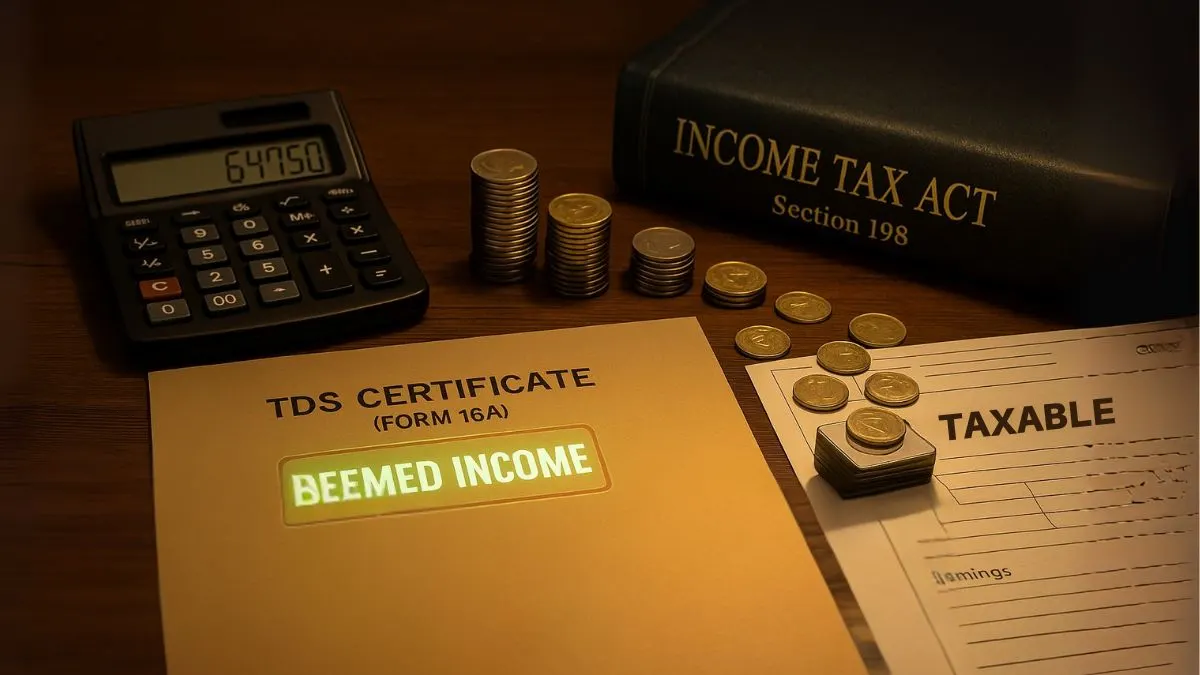
The concept of Tax Deducted at Source (TDS) plays a very important role in India’s taxation system. It ensures that tax collection happens right at the source of income. But what happens to the income once TDS is deducted? Do you still treat that deducted amount as part of your income, even though it never came into your bank account?
This is exactly where Section 198 of Income Tax Act comes into play. The law clearly says that tax deducted at source shall be deemed to be income received by the taxpayer. In simpler words, even if a portion of your salary, interest, or professional income has been deducted as TDS, you must treat that deducted amount as income you have already received.
What is Section 198 of Income Tax Act?
Section 198 provides that:
- All sums deducted in accordance with the provisions of Sections 192 to 195 shall be deemed to be income received by the taxpayer.
- This applies to salaries, interest, dividends, and other payments where TDS rules are applicable.
For example, if your salary is ₹10,00,000 and your employer deducts ₹1,00,000 as TDS, your gross income will still be considered ₹10,00,000. The TDS amount deducted from John’s salary is considered as income already received by him.
This prevents confusion in taxation and ensures that taxpayers correctly report gross income and not just net income.
Why is Section 198 Important?
Section 198 removes ambiguity in income reporting. If TDS were not treated as income received, people might wrongly understate their earnings. By deeming TDS as income received, the law ensures:
- Correct computation of gross income – TDS doesn’t reduce your income, it’s only an advance tax payment.
- Uniform reporting – Every taxpayer declares income in a consistent manner.
- Tax compliance – It eliminates the possibility of taxpayers underreporting their income by excluding deducted amounts.
Also Read: TDS on Foreign Payments: Everything You Need to Know
Illustration to Understand Section 198 Better
Let’s say John earns a salary of ₹50,000 per month (₹6,00,000 annually). His employer deducts ₹5,000 per month as TDS (₹60,000 annually).
- Without Section 198: John might wrongly assume his income is only ₹5,40,000 since that is what he actually receives in his account.
- With Section 198: John must declare his income as ₹6,00,000. The ₹60,000 deducted is deemed to have been received by him, even though it was directly paid to the Government.
Connection with Sections 192 to 195
Section 198 works in connection with the TDS sections like:
- Section 192 – TDS on salaries
- Section 193 – TDS on interest on securities
- Section 194 – TDS on dividends
- Section 194A – TDS on interest other than securities
- Section 195 – TDS on payments to non-residents
It ensures that all sums deducted in accordance with these provisions are treated as part of the taxpayer’s income.
Judicial Interpretations
Courts have consistently upheld that TDS is part of income received. Even if the cash is not physically received by the taxpayer, it is deemed income because it reduces his tax liability.
Impact of Section 198 on Taxpayers
- Transparency – Taxpayers can see TDS as part of their Form 26AS and AIS.
- Advance Credit – Since TDS is considered income, the deducted amount appears as credit in your tax account.
- Clarity in Gross Income – Prevents confusion between net and gross income reporting.
Special Case – Section 198 (Amendments)
Earlier, even dividends were covered under this section. But with changes in taxation rules on dividends, there are certain exceptions today. Still, the principle remains: TDS deducted is deemed income received.
Also Read: TDS on Interest (FDs, Loans, etc.): Everything You Must Know
Practical Example for Businesses
If a company pays ₹10 lakh to a contractor and deducts ₹1 lakh as TDS, the contractor must still show ₹10 lakh as gross income. The TDS amount becomes a credit available when filing returns.
Section 198 in Simple Language
Think of it like this – TDS is your money, just paid to the Government on your behalf. So, even if you don’t receive it in your hand, you have “received” it in the eyes of the law.
Key Takeaways
- Tax deducted is income received.
- All sums deducted in accordance with the provisions of sections 192 to 195 must be treated as income received.
- The TDS amount deducted from John’s salary is considered as income already received by him.
- Section 198 prevents underreporting of income and ensures consistency.
Conclusion
Section 198 of Income Tax Act is a simple yet powerful provision that ensures tax deducted at source shall be deemed to be income received. It provides clarity for both taxpayers and authorities, ensuring that all sums deducted under Sections 192 to 195 are treated as gross income.
So, the next time you file your ITR, remember – your TDS is not a loss, but income already received and credited against your tax liability.
👉 Want to ensure accurate tax filing and maximize your TDS refunds? Visit Callmyca.com – our experts will guide you step by step and help you file with confidence.











